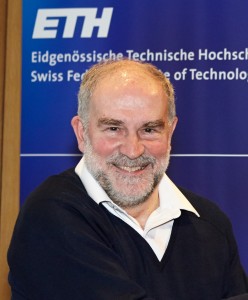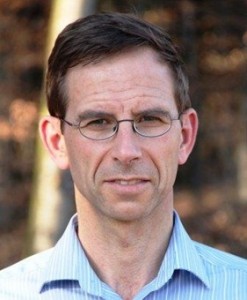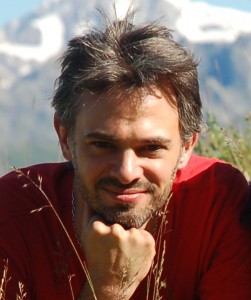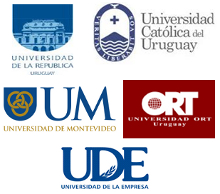Bioinformatics: Algorithms applied to molecular sequences with practical applications
Dr. Gastón Gonnet: D-INFK, ETH Zurich, Switzerland
 Abstract: We describe some bioinformatics applications based on molecular sequences in other disciplines which are not obvious. We will describe these applications and their algorithms without getting into too much detail, mainly showing the benefits for the area. The areas include Biology and Medicine, which are the classical and some other more surprising like agriculture, legal, ecology, archeology, genealogy, etc.
Abstract: We describe some bioinformatics applications based on molecular sequences in other disciplines which are not obvious. We will describe these applications and their algorithms without getting into too much detail, mainly showing the benefits for the area. The areas include Biology and Medicine, which are the classical and some other more surprising like agriculture, legal, ecology, archeology, genealogy, etc.
Bio: Professor Gonnet started his academic carreer in the analysis of algorithms. Later, in 1980, together with Keith Geddes, he formed the Symbolic Computation Group, a group devoted to research in Symbolic Computation or Computer Algebra, and to the development of the Maple Algebra System.Maple has found its way into the practical world, aiding engineers to do their computations, assisting scientists in their research and helping students to learn mathematics. In 1983-84, the University of Waterloo and Oxford University Press became partners for the computerization of the Oxford English Dictionary. At that time, Professor Gonnet and colleagues founded the “Centre for the New Oxford English Dictionary”. The Centre has attracted a lot of activity around the work on the dictionary and also in connection with the research being done with large text databases. Some of these activities reached their climax with the publication of the second edition of the dictionary, a work which would have not been possible without intelligent text processing. The main contributions of this project have been in the areas of fast text searching, text structuring and text transformations which then were reused in bioinformatics. In 1989, Professor Gonnet accepted a position with E.T.H. Zurich, where he is working in Bioinformatics. Professor Gonnet and Prof Steven Benner founded the ETH Computational Biochemistry Research Group. The CBRG was responsible for the first self-matching of an entire protein database. The CBRG specializes in sequence analysis, models of evolution and phylogeny construction. The work in bioinformatics has been extended to various aspects including the creation and curation in 2005 of the OMA database, the largest database of orthologous relations. The CBRG is a member of the Swiss Institute of Bioinformatics. In 1989, Professor Gonnet was awarded the Information Technology Association of Canada annual award for his contributions to computer algebra and text searching. In 2012 he was awarded a Dr. Honoris Causa by the Universidad de la Republica in Uruguay for the various contributions to computer science. Professor Gonnet has started several companies related to his research, most notably Open Text and Waterloo Maple, both companies located in Canada. Currently he is Chief Scientist of CeeqIT and Porfiau, both recent startups in Waterloo, Canada.
Privacy Concerns: The Clash between Technological Capabilities and Societal Expectations
Dr. Ernst L. Leiss: University of Houston, USA
 Abstract: Society has certain basic expectations: People and institutions, including governmental organizations, must behave in accordance with the law and in conformity with a society’s ethics. Moreover, a society’s laws are generally expected to reflect its ethics. On the other hand, technology increasingly provides capabilities that are unexpected and generally not well known. These technological capabilities may clash with a society’s laws and ethics. In particular, modern societies have certain expectations of privacy; these expectations may be contradicted by the capabilities new technology provides. In this talk, we examine a wide-ranging spectrum of computer-based technologies that may well be at variance with society’s general privacy expectations. We look at statistical databases where queries should not be permit access to individual entries; at various technologies that permit the continual or intermittent monitoring of an individual’s location; at monitoring communications, including problems created by the use of encryption; the use of watermarking to trace web content; and the sequencing of an individual’s complete genome. In some cases, the technology intrudes on an individual’s privacy, in some cases, its use may be viewed as neutral, and in some cases technology may be thought to go too far in protecting privacy.
Abstract: Society has certain basic expectations: People and institutions, including governmental organizations, must behave in accordance with the law and in conformity with a society’s ethics. Moreover, a society’s laws are generally expected to reflect its ethics. On the other hand, technology increasingly provides capabilities that are unexpected and generally not well known. These technological capabilities may clash with a society’s laws and ethics. In particular, modern societies have certain expectations of privacy; these expectations may be contradicted by the capabilities new technology provides. In this talk, we examine a wide-ranging spectrum of computer-based technologies that may well be at variance with society’s general privacy expectations. We look at statistical databases where queries should not be permit access to individual entries; at various technologies that permit the continual or intermittent monitoring of an individual’s location; at monitoring communications, including problems created by the use of encryption; the use of watermarking to trace web content; and the sequencing of an individual’s complete genome. In some cases, the technology intrudes on an individual’s privacy, in some cases, its use may be viewed as neutral, and in some cases technology may be thought to go too far in protecting privacy.
Bio: Ernst Leiss earned graduated degrees in engineering (Dipl.-Ing., TU Vienna, 1975), computer science (M. Math., U. Waterloo, 1974), and mathematics (Dr. techn., TU Vienna, 1976). He was a post-doctoral fellow at the University of Waterloo (1976/7) and taught at the Universidad de Chile in Santiago in 1978. He then moved to the US where in fall 1979 he joined the faculty of the Department of Computer Science at the University of Houston, where he still is. His research interests include formal language theory, high-performance computing, and security. He has supervised 17 Ph. D. dissertations and over 100 M. S. theses. He is author of six books and over 160 refereed conference and journal publications. Leiss has participated in every CLEI conference since 1992. He was heavily involved with LANC, defining a sustainable model. He has participated in numerous program committees, in particular as General Program Chair of the Quito conference in 2011 which for the first time implemented symposia. He has participated in one ECI course in Buenos Aires and two ERTIC courses in Asuncion. In addition, he has taught courses in Syria, Brazil, Italy, Spain, Germany, Finland, Tunisia, and Morocco; to date, he has lectured in 32 different countries. Leiss has participated in the accreditation of computer science programs. He has been an ACM Distinguished Lecturer since 1991. He has held administrative positions at his university and chaired various committees; in particular, as President of the Faculty Senate in 1994, he initiated a major restructuring of the university.
Models Engineering. Application to organizational alignment in software-intensive systems
Dr. Francisco Ruiz: University of Castilla – La Mancha, Spain
Abstract: Today organizations demand to its IT departments more and more agile answers and solutions better aligned with corporate necessities and objectives. As reaction to this reality, software engineering has put attention to the organizational context of the software-intensive systems, arising paradigms like SOC (services oriented computing) and BPM (business process management). On the other hand, the ‘Model-driven Engineering’ (MDE) initially arose to increase the efficiency and effectiveness during the software development, but it has advantages that are feasible of applying in many other areas, like the organizational improvement. This way we face the challenge of researching new environments (methods, techniques, and software technology) based on the integration of this three aforementioned paradigms with the goal to attend two key necessities of software industry: agility and better alignment with the organization. In this challenge many questions have opened and frequently the answers need a multidisciplinary effort. Among the different works and proposals, details of two will be presented: i) Applying MDE technology to obtain service oriented UML models starting from business process models in BPMN; and ii) Applying metamodeling to support the IT governance, especially in order to facilitate the organizational change and improvement.
Bio: Full professor at University of Castilla-La Mancha (Spain). His professional activity began in 1984 with experiences as business and system analyst, project manager, IT director, and consultant. From 1989 he is academic staff, including more than 10 years as dean of Computer Science Faculty and last years as responsible of Master on Computing Engineering. His current research interests include the integration of paradigms SOC (service-oriented computing), MDE (model-driven engineering), and BPM (business process management. He is author of two hundred papers, including 26 articles in indexed journals, and books, chapters, others articles, congresses, conferences and workshops. He belongs to ACM and IEEE-CS.
Spatial Cognition in Biologically Inspired Robots
Dr. Alfredo Weitzenfeld: University of South Florida, USA
 Abstract: The study of behavioral and neurophysiological mechanisms involved in rat spatial cognition provides a basis for the development of computational models and robotic experimentation of goal-oriented task behaviors. These models and robotics architectures offer neurobiologists and neuroethologists alternative platforms to study, analyze and evaluate new hypotheses on spatial cognition. In this talk we discuss a comparative analysis of spatial cognition in rats and robots in goal-oriented tasks. Studies in rat spatial cognition are used to develop computational models of the hippocampus to produce a cognitive map of the environment that drives robot experimentation. Current and future directions of this research are discussed.
Abstract: The study of behavioral and neurophysiological mechanisms involved in rat spatial cognition provides a basis for the development of computational models and robotic experimentation of goal-oriented task behaviors. These models and robotics architectures offer neurobiologists and neuroethologists alternative platforms to study, analyze and evaluate new hypotheses on spatial cognition. In this talk we discuss a comparative analysis of spatial cognition in rats and robots in goal-oriented tasks. Studies in rat spatial cognition are used to develop computational models of the hippocampus to produce a cognitive map of the environment that drives robot experimentation. Current and future directions of this research are discussed.
Bio: Alfredo Weitzenfeld is a Professor at the Department of Computer Science and Engineering in the College of Engineering at the University of South Florida where he directs the Biorobotics Laboratory. Dr. Weitzenfeld obtained a BS in Electrical Engineering from Technion in Israel, an MS in Computer Engineering and a PhD in Computer Science both from the University of Southern California in Los Angeles. He is one of the main developers of the Abstract Schema Language (ASL) and the Neural Simulation Language (NSL), described in “The Neural Simulation Language NSL: A System for Brain Modeling” (co-authors M. Arbib and A. Alexander) published in 2002 by MIT Press. In addition to his research in biologically-inspired robotics and cognitive robotic systems, Dr. Weitzenfeld is also involved in the organization of international robotics competitions and conferences, including the Latin American Robotics Competition (LARC), Latin American Robotics Symposium (LARS), RoboCup 2012 World Championship in Mexico City, and International Conference on Advanced Robotics (ICAR) held in November 2013 in Montevideo, Uruguay. His research has been funded by different government agencies including CONACYT in Mexico and NSF in USA. He is a senior editor of the Journal of Intelligent & Robotic Systems.
Recent Advances in Non-Local Image Restoration and Video Inpainting
Dr. Andrés Almansa: CNRS LTCI, Telecom ParisTech, France
Abstract: Digital images and sequences are most often corrupted by noise, blur, occlusions and many other deteriorations. A detailed mathematical model of the acquisition device allows to cast the problem of restoring the original image from corrupted measurements as an ill-posed inverse problem. Hence, in order to solve it numerically, we need to adopt a regularizing prior. Most common regularizers used in the early days of image processing, were based on linear (Gaussian, Wiener) or adaptive filters. In contrast, non-local priors do not impose any particular structure on local image patches. They only assume that patches within a natural image are self-similar, meaning that the same patch appears in different locations of the same image. The introduction of non-local methods for image denoising in 2005 allowed a major leap forward in terms of restored image quality. More recently (since 2012) a more precise Bayesian formulation of the non-local prior allowed a further increase in performance, and further flexibility to apply it to more ill-posed inverse problems, including image inpainting which consists in reconstructing the image behind an occluding object, based on the visible surrounding context. From the computational perspective, however, non-local methods are several orders of magnitude more expensive than linear filtering. A major part of this talk will be devoted to the algorithmic acceleration techniques available for this kind of methods. In particular, a generalization of Adobe’s PatchMatch algorithm allows to reduce the computational complexity of video inpainting from several days to a few hours on a single processor. Similarly our covariance tree allows to accelerate the non-local Bayes restoration algorithm even in non-structured situations like 3D point clouds or learning-based restoration.
Bio: Andrés Almansa received his HDR, Ph.D. and M.Sc./Engineering degrees in Applied Mathematics and Computer Science from Université Paris-Descartes, ENS Cachan (France) and Universidad de la República (Uruguay), respectively, where became an Associate Professor in 2004. His current interests as a CNRS Research Scientist at Telecom ParisTech (since 2007) include image restoration and analysis, subpixel stereovision and applications to earth observation, high quality digital photography and digital film restoration. He published over 40 peer-reviewed articles and supervised 8 PhD theses in those areas.
Mobile Cloud Networking
Dr. Torsten Braun, University of Bern, Switzerland
 Abstract: The EU FP7 Mobile Cloud Networking project (www.mobile-cloud-networking.eu) investigates the implementation of 4G/LTE mobile networks using processing and storage platforms hosted in the cloud. In particular, at our research group (cds.unibe.ch) we are investigating how to integrate Information-Centric Networking into the Mobile Cloud Networking architecture, i.e., how to support caching of contents by ICN routers and base stations. We further describe preliminary results about running Radio Access Network functions on cloud processing platforms. Moreover, we discuss how to distribute user equipment context information in such a cloud-based LTE core network. Since end systems are expected to be permanently connected to the wireless network, energy consumption becomes an important issue. We have developed WiFi MAC layer mechanisms to support energy-efficient operations for continuous data transmissions.
Abstract: The EU FP7 Mobile Cloud Networking project (www.mobile-cloud-networking.eu) investigates the implementation of 4G/LTE mobile networks using processing and storage platforms hosted in the cloud. In particular, at our research group (cds.unibe.ch) we are investigating how to integrate Information-Centric Networking into the Mobile Cloud Networking architecture, i.e., how to support caching of contents by ICN routers and base stations. We further describe preliminary results about running Radio Access Network functions on cloud processing platforms. Moreover, we discuss how to distribute user equipment context information in such a cloud-based LTE core network. Since end systems are expected to be permanently connected to the wireless network, energy consumption becomes an important issue. We have developed WiFi MAC layer mechanisms to support energy-efficient operations for continuous data transmissions.
Bio: Torsten Braun got his Ph.D. degree from University of Karlsruhe (Germany) in 1993. From 1994 to 1995 he has been a guest scientist at INRIA Sophia-Antipolis (France). From 1995 to 1997 he has been working at the IBM European Networking Centre Heidelberg (Germany) as a project leader and senior consultant. He has been a full professor of Computer Science at the University of Bern (Switzerland) and head of the research group “Communication and Distributed Systems” since 1998. He has been member of the SWITCH (Swiss education and research network) board of trustees since 2001. Since 2011, he has been vice president of the SWITCH foundation.
The Phone as Wellness Guardian
Dr. Mario Gerla, UCLA, USA

Abstract: Smart phones are becoming more powerful and pervasive every year, supporting an increasing number of functions well beyond the original service of making phone calls while on the move. One important, emerging function is wellness – protecting the health of the owner. Phones today can be used to monitor known health condition (eg arrhythmia, diabetes. etc). They can monitor activities (ie, walking, running, eating, etc). They can also monitor our routes (eg, path taken, distance travelled, etc). All this information can be combined and correlated to come up with important wellness advisories for the owner. This talk will review the most recent advances in smart phone sensors as they relate to health and will review representative wellness applications including the UV Guardian application – protecting the owner from UV rays overexposure.
Bio: Dr. Mario Gerla is a Professor in the Computer Science Dept at UCLA. He holds an Engineering degree from Politecnico di Milano, Italy and the Ph.D. degree from UCLA. He became IEEE Fellow in 2002. At UCLA, he was part of the team that developed the early ARPANET protocols under the guidance of Prof. Leonard Kleinrock. He joined the UCLA Faculty in 1976. At UCLA he has designed network protocols including ad hoc wireless clustering, multicast (ODMRP and CODECast) and Internet transport (TCP Westwood). He has lead the ONR MINUTEMAN project, designing the next generation scalable airborne Internet for tactical and homeland defense scenarios. He is now leading several advanced wireless network projects under Industry and Government funding. His team is developing a Vehicular Testbed for safe navigation, contente distribution, urban sensing and inteligente transport. Parallel research activities are wireless medical monitoring using smart phones and cognitive radios in urban environments. He has served as a Technical Program Committee member of many international conferences, and is active in the organization of conferences and workshops, including MedHocNet and WONS. He serves on the IEEE TON Scientific Advisory Board. He was recently recognized with the annual MILCOM Technical Contribution Award for 2011 and the IEEE Ad Hoc and Sensor Network Society Achievement Award in 2011.





